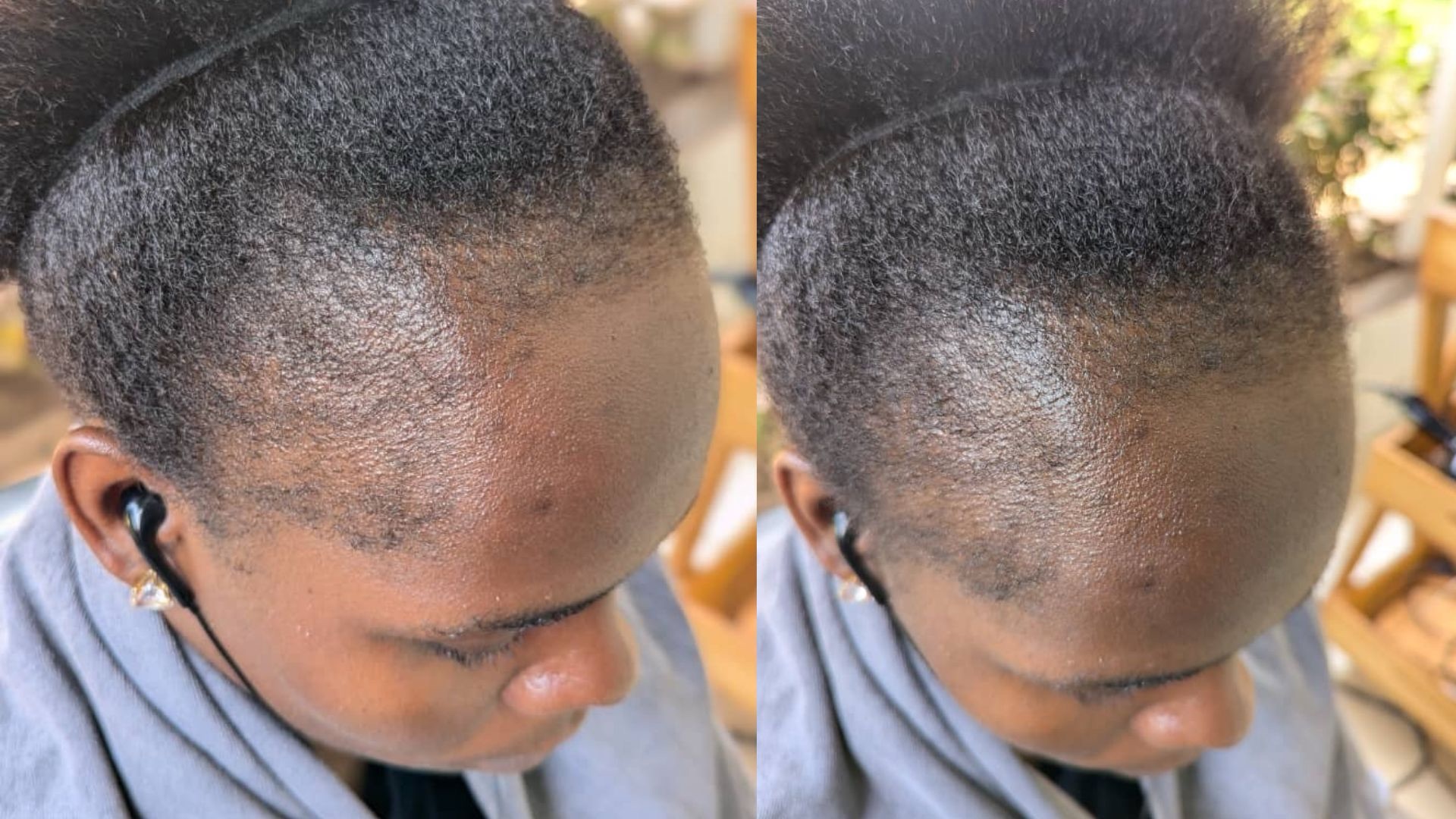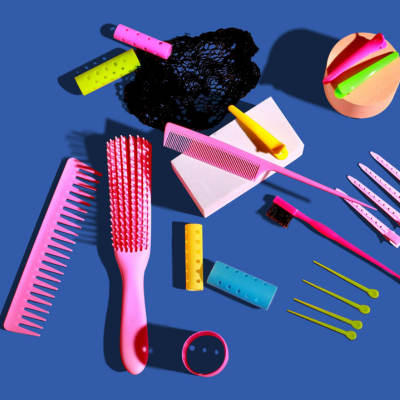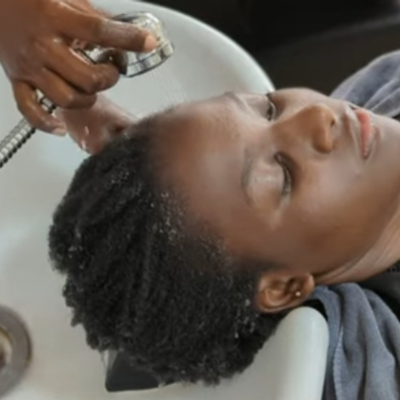- Support 24/7
- +1 (480) 468-4543
- livara@mylivara.com
Thinning Edges Are Not Normal: What You Need To Know About Traction Alopecia

What Is A Moving Scalp? Simple Tips on How To Work With One
July 16, 2024
Moisture: Unveiling the Secrets to Healthy, Happy Hair
July 19, 2024
Ever stared in the mirror and noticed your once-full hairline creeping back a little further each day? Or maybe you’ve seen that the edges you love to lay with gel are becoming increasingly sparse. Sister (or brother), you’re not alone. This frustrating phenomenon, known as traction alopecia, is a surprisingly common concern for many Black women.
We all love to rock our hair in different styles – braids, weaves, bantu knots – but what if these styles, the ones that make us feel confident and beautiful, are actually contributing to hair loss? It sounds crazy, right? But traction alopecia is a real issue, and understanding it can be the first step towards getting your edges back on track.
This article dives deep into the world of traction alopecia, unpacking the “why” behind the thinning edges and offering solutions to keep your crown looking full and fabulous. So, grab a cup of tea (or your favorite beverage), settle in, and let’s get to the root of the problem (pun intended!).
Understanding Traction Alopecia
Imagine your hair as a delicate flower. The stronger the stem, the better it can withstand wind and rain. But if you constantly pull on that stem, eventually, it weakens and breaks. That’s essentially what happens with traction alopecia.Hairstyles that put constant pulling tension on the scalp, like tight braids, weaves sewn in too close to the hairline, or even repetitive high ponytails and sleek buns, can damage hair follicles over time. This persistent pulling weakens the follicles, hindering their ability to grow healthy hair, leading to that dreaded thinning around the hairline and temples.
Why Black Women Are More Susceptible to Traction Alopecia
Now, hold up before you ditch your braids and weaves in a frenzy! Traction alopecia can affect anyone who wears styles that put constant strain on the scalp. But here’s the thing: Black women have a unique relationship with their hair. Our love for versatility and protective styles – braids, weaves, crochet styles, wigs – is unmatched. But sometimes, those very styles that give us life can also lead to unintended consequences.
Let’s break it down. Our naturally curly and coily hair textures are a source of endless beauty, but they also come with a twist (literally!). The delicate kinks and coils of our strands make them more prone to breakage. Now, imagine weaving these beautiful strands into intricate cornrows – a necessary step for many protective styles. While cornrows are a work of art, when done too tightly, they can put immense stress on the scalp, weakening those delicate follicles.
And it doesn’t stop there. We all love a sleek bun or a high ponytail, a classic that never goes out of style. But when these styles are achieved with a fistful of gel and pulled back ultra-tight, it’s like constantly tugging on our edges. Over time,this tension can wreak havoc on the hair follicles in those areas, leading to that dreaded thinning.
It’s not about ditching the styles we love; it’s about understanding how they can impact our hair health and making informed choices.
Fighting Back: A Multi-Pronged Approach to Traction Alopecia
So, you’ve noticed some thinning around your edges. Don’t despair! Traction alopecia is often reversible with a multi-pronged approach that addresses both hair growth and scalp health. Here’s how to get your hair journey back on track:
- Give Your Hair a Break:
- Less is More: While we all love to rock different hairstyles, take some time off from tight styles and extensions. Allow your scalp to breathe and recover between protective styles.
- Looser Styles are Your Friend: If you’re already dealing with thinning edges, give your hair a break by holding it in looser styles like natural twists. While styles like braids and cornrows aren’t inherently bad, they tend to exert tension on the scalp and hair follicles, so it’s best to stick to loose styles like natural twists as you grow back your edges. Such styles offer the protection you crave while minimizing tension on your scalp.
- Crochet with Care: When it comes to crochet styles, make sure your hairstylist isn’t cornrowing too tight
- Wig Wisdom: Wigs can be a fantastic styling option, but the glue some of them come with can end up doing much more harm than good. Look for glue-less wigs or those with adjustable bands for a comfortable fit.
- Scalp Care Sanctuary:
- The Power of Massage: Gentle scalp massages with nourishing oils like jojoba or castor oil can improve blood flow to the scalp, promoting hair growth and relaxation. The Livara Tanzanite Hair Oil hosts an assortment of nourishing natural oils like castor oil which are great for thinning edges. Focus on circular motions with light pressure, spending extra time on the areas experiencing thinning.
- Exfoliate for Growth: Build-up of dead skin cells can hinder hair growth. Exfoliate your scalp once or twice a month with a clarifying treatment like the Tsavorite Clarifying Treatment Hair Shampoo to remove excess buildup of oils and products and promote healthy hair follicles.
- Moisture is Your Best Ally:
- Hydration Hero: Dry, brittle hair is more susceptible to breakage. Deep condition your hair at least once a week with a rich, hydrating conditioner or hair mask. Look out for ingredients like shea butter, coconut oil, and avocado oil that are known for their moisturizing properties.
- Seal the Deal: After deep conditioning, lock in moisture with a hair oil or butter. Sealing the hair cuticle helps prevent moisture loss and keeps your strands soft and supple. Lookout for natural oils like argan, avocado, coconut, jojoba, or butters like shea butter to seal in moisture.
- Seek Expert Guidance:
- The Power of a Trichologist: A trichologist is a hair specialist who can assess your hair loss pattern, diagnose the cause, and recommend personalized treatment options. This may include topical medications or supplements to promote hair growth. Seeking expert advice may be a necessary step if thinning edges persist.
- Scalp Massaging:
- While scalp massages are a wonderful addition to a hair care routine for overall scalp health and potentially promoting hair growth, it’s important to manage expectations when it comes to treating traction alopecia. Here’s how to integrate scalp massages into your strategy:
- Scalp Massages: Scalp massages are a fantastic way to promote blood flow to the scalp, which can contribute to a healthy hair growth environment. They can also be incredibly relaxing, reducing stress which can sometimes exacerbate hair loss. However,when it comes to treating traction alopecia, scalp massages are best used alongside other strategies, not as a standalone solution.
Here’s how you can incorporate scalp massages into your routine:
- Massage Magic: Include gentle scalp massages with nourishing oils like jojoba or castor oil into your hair care routine. Focus on circular motions with light pressure using your fingertips, spending extra time on areas experiencing thinning. Aim for a few minutes of massage 2-3 times a week.
- Teamwork Makes the Dream Work: Combine regular scalp massages with other strategies like switching to looser hairstyles, prioritizing scalp health, and maintaining a healthy diet.
- Special Note: Scalp massages can be a great addition to your hair care routine, but they are unlikely to reverse significant traction alopecia on their own. Consistency and a multi-pronged approach are key to seeing improvement in your edges.
Remember: Consistency is key! By incorporating these practices into your hair care routine and allowing some time for your hair to recover, you can see a significant improvement in the health and fullness of your edges.
Prevention is Power: Building a Lasting Fortress for Your Edges
The good news is that traction alopecia is largely preventable. By becoming a proactive hair warrior, you can keep your edges strong and thriving, allowing you to rock your favorite styles with confidence. Here are some key strategies to incorporate:
- Be a Gentle Stylist:
- Ditch the Strain: When styling your hair, avoid pulling your strands too hard in the name of achieving a sleek style. Treat your strands with love and use gentle detangling tools to minimize breakage.
- Finger detangling is your friend: Instead of small painful combs, try finger detangling to gently remove knots and tangles. This method allows you to have more control over the pressure applied to your scalp.
- Loosen Up!:
- Embrace Looser Braiding Techniques: Always ask your hairstylist not to braid too tight. If you feel excessive pain as the style is being installed, do what’s best for your scalp and speak up. If you don’t, soon you’ll start to notice those painful bumps and those white bulbs come out from your scalp (this is an indicator that your hair follicles are being pulled too much).
- Say No to Tight Ponytails and Buns: We all love a sleek updo, but avoid pulling your hair back so tight it feels like it’s lifting your face. Aim for a looser, more relaxed style to minimize tension on the hairline.
- Hair Ties Matter: Ditch the harsh elastic hair ties. Hair ties, particularly those with metal parts or rough seams, can create friction and damage the hair shaft, resulting in breakage and hair loss around your hairline. These tend to tug at the hair and pull out entire hair follicles. Use fabric hair ties or scrunchies that are gentler on your hair and don’t cause breakage around the hairline.
- Variety is the Spice of Life (and Healthy Hair):
- Don’t Get Stuck in a Rut: Switch up your hairstyles regularly to avoid putting constant strain on the same areas of your scalp. Give your edges a break by alternating between braids, twists, loose updos, and wearing your hair down in its natural texture.
- Moisturize, moisturize, moisturize:
- Moisturize Regularly: Dry, brittle hair is more prone to breakage. Develop a consistent moisture routine for both your scalp and hair. Moisturize regularly with a water-based moisturizer like the Tsavorite Spritz Moisturizer or even simply with water in a spray bottle. Seal in the moisture with a natural oil or butter every 3/4 days.
- Deep Condition Regularly: Include deep conditioning treatments in your hair care routine at least once a week or biweekly. This helps replenish moisture and keeps your hair strands strong and flexible.
- Diet and Sleep for the Win:
- Fuel Your Hair Growth: Eating a balanced diet rich in essential vitamins and minerals like biotin and iron can contribute to overall hair health. Learn more about the essential vitamins and minerals for healthy hair growth here.
- Beauty Sleep is Real: Aim for 7-8 hours of quality sleep each night. Sleep allows your body to repair and replenish itself, which can also benefit your hair growth.
Remember: Prevention is all about building healthy habits for your hair. By incorporating these tips into your routine and being mindful of how you style your hair, you can significantly reduce your risk of traction alopecia and keep your edges looking fabulous for years to come.
Conclusion: Owning Your Hair Journey, Edges and All
Traction alopecia can be a frustrating experience, but remember, you’re not alone. By understanding the causes and taking proactive steps towards prevention and treatment, you can keep your edges strong and healthy. Embrace protective styles that prioritize scalp health, indulge in a nourishing scalp care routine, and celebrate your natural hair texture.
Here’s the empowering truth: Your hair journey is unique, and it’s about finding what works best for you. Don’t be afraid to experiment with different styles, but always prioritize healthy practices. With a little knowledge and a lot of self-love, you can rock your favorite hairstyles with confidence, knowing your edges are thriving underneath. Because you are a gem.



